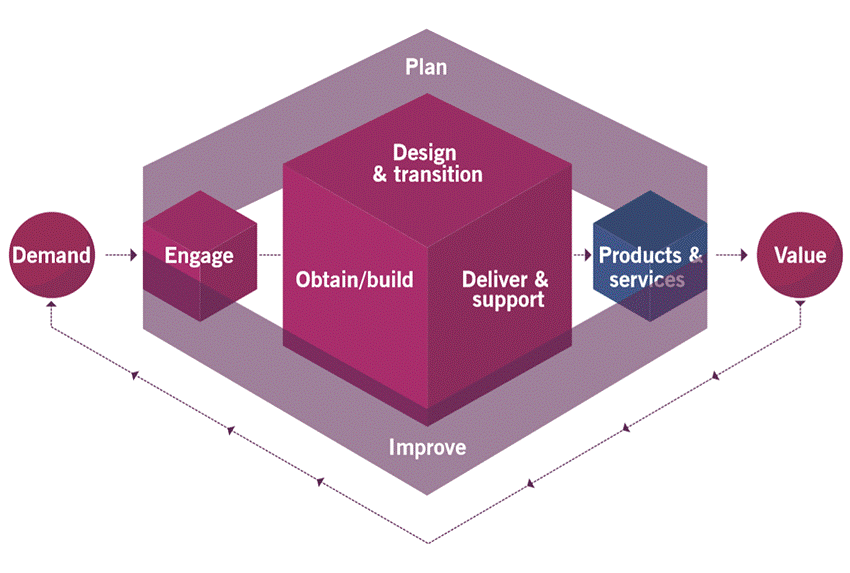Now that the ITIL 4 foundation has been released, with the ITIL managing professional and ITIL strategic leader modules scheduled for release later this year, it's time to ask: What's in it for you?
Here's what you'll find in the newest ITIL version. But is it enough to give a new push to the most hated, yet most implemented, framework within ITSM?
ITIL 4: Key concepts
In the first part of ITIL 4, I see a lot of familiar terms, such as service providers, stakeholders, risks, etc. But the focus on value is new.
The definition of service management is: A set of specialized organizational capabilities for enabling value to customers in the form of services. And in that definition, value is described as a bidirectional relationship where value is co-created.
That is also where service relationships come in. Value is how the consumer of the service experiences it—nothing more, nothing less. There's a big focus shift to customer experience (CX) instead of on delivering services from previous ITIL versions. That is important, since it aligns with the No. 1 focus in service management.
Another focus shift goes from processes toward realizing outcomes. And taking the value focus into consideration, it is pretty straightforward to understand that this outcome has to bring value. An important role to get to this outcome is laid out in service relationships. So, again, a big focus on collaboration.
[ Related: How to boost enterprise collaboration and speed in your pipeline ]
The guiding principles
Personally, one of my favorite parts of ITIL 4 is its guiding principles—recommendations that guide an organization in all circumstances. To me, the guiding principles make ITIL 4 a lot more practical, so they will certainly get a place of honor on one of the walls in our office.
These principles are:
- Focus on value: Keep in mind that value is all about perception, which is where CX and user experience (UX) come in.
- Start where you are: Don't discard everything you have previously built up, but keep what works and make adjustments where needed.
- Progress iteratively with feedback: Embrace agile, improving even big projects in small steps and actively look for feedback.
- Collaborate and promote visibility: Collaborate everywhere, with service providers, customers, dev, ops, etc. Keep in mind that collaboration does not equal consensus, and good decisions are only possible when data is visible.
- Think and work holistically: Move toward making your organization a more central part of the overall effort that helps others focus on delivering value.
- Keep it simple and practical: Don't try to cover everything; rather, create rules to handle exceptions.
- Optimize and automate: Do this wherever you can, so long as it does not lead to a worse customer experience.
These are great additions to the ITIL 4 foundation, and I hope to see them worked out in more detail in the other materials that are going to be released. Especially when it comes to collaboration, I like how broad the focus is, but I would like to see more elaboration of how or what that collaboration should look like, especially when blending different frameworks and teams together, such as DevOps, agile, and lean.
Four dimensions
In every ITIL concept, value and collaboration play a central role, which is evident as well in the four dimensions of ITIL. Next to the usual suspects—people, process, tools, and the introduction of value streams—ITIL adds two new dimensions: partners and suppliers.
Since the biggest challenges and goals I currently see in the industry are around CX and anything people-related, this part is interesting. In the dimension of "organization and people," I see some good things, such as a culture of transparency, shared values, leadership, and trust.
But I am also looking forward to seeing if ITIL 4 will come out with more elaborate guidelines around culture, people, and transparency, since these guidelines remain vague.
The addition of the dimension "partners and suppliers" speaks to the reality of organizations that are outsourcing more and more business-critical things. And, of course, the value streams, which are familiar to anyone who has implemented lean, are a good way of working on continuous improvement.
[ Related: What's wrong with your value stream mapping ]
ITIL service value system and value chain
The service value system talks about how all components and activities of an organization work together to facilitate value creation. The central part of the system is the service value chain, which explains the actual activities: plan, improve, engage, design and transition, obtain and build, and deliver and support.
These activities do not necessarily flow in one linear way. Especially when keeping to the "progress iteratively" approach out of the guiding principles, a series of activities can be repeated.
Figure 1. The ITIL service value chain with all activities. Source: ITIL® Foundation, ITIL 4 edition.
ITIL practices
Some 34 ITIL practices, divided into three categories—general management, service management, and technical management—replace the 26 processes in the previous ITIL version. These, in turn, take all four dimensions of service management into account: organizations and people, information and technology, partners and suppliers, and value streams and processes.
As with other changes in ITIL, it should make things more practical and easier to learn from, or even enable you to implement bits and pieces of it in your organization. Not all practices are covered just yet in the ITIL 4 foundation, so we will have to wait to see what the actual differences entail.
The verdict
ITIL 4 is very promising, and I am looking forward to the other content that will be released later in the year. A lot of the previous criticism of ITIL came from the fact that is was a bit too theoretical and too process-oriented, and not on par with today's challenges.
ITIL 4 does a good job of relating to topics such as CX, value, people focus, and collaboration, but I was hoping to see some more elaborate guidelines to help out with that.
This is especially so when talking about how ITIL interacts with DevOps and agile. There are a lot of mentions, but ITIL 4 does not offer anything substantial on the subject. More guidelines on how to actively glue them together, or at least achieve a better way of collaborating, would have been nice.
The ITIL specification takes on some of the good things from different frameworks. But in many places it seems to reference DevOps without actually explaining how to overcome misunderstandings and challenges from the DevOps-oriented teams within the business that must actively collaborate with ITIL-oriented teams.
[ Related: Why IT frameworks aren't working—and how to fix them ]
Where's ESM?
Also, enterprise service management (ESM) seems to be partially forgotten. Even though much of the ITIL 4 material talks about collaboration and breaking down silos, there is no discussion about how to actually collaborate within the organization with non-IT service departments.
The notion of service providers being able to be both internal and external probably comes closest to that, but to me it is not explicit and practical enough. I think that ITIL 4 truly is a missed opportunity given the current reality of ESM.
Nonetheless, I look forward to the extra content that will come out this year, and there is value in considering ITIL 4 if you were let down by previous versions.
ITIL is coming closer to serving as guidelines, practices, and handholds that you can actually implement, rather than many being only well-defined processes that might have never made it off of your shelves. Time will tell if it does go deep enough, but the foundation so far looks promising.
Keep learning
Choose the right ESM tool for your needs. Get up to speed with the our Buyer's Guide to Enterprise Service Management Tools
What will the next generation of enterprise service management tools look like? TechBeacon's Guide to Optimizing Enterprise Service Management offers the insights.
Discover more about IT Operations Monitoring with TechBeacon's Guide.
What's the best way to get your robotic process automation project off the ground? Find out how to choose the right tools—and the right project.
Ready to advance up the IT career ladder? TechBeacon's Careers Topic Center provides expert advice you need to prepare for your next move.




